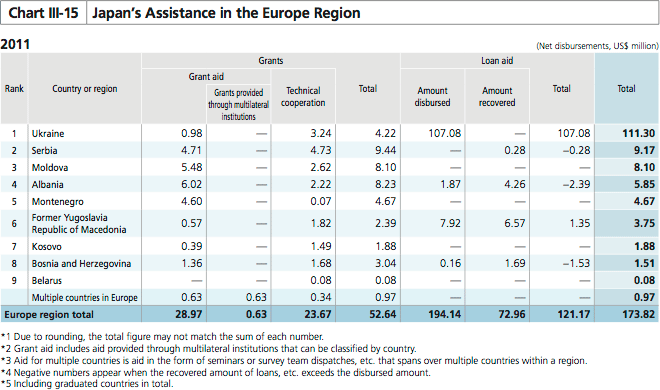Japan's Official Development Assistance White Paper 2012
8. Europe
Many of the countries in Central and Eastern Europe and the European region of the former Soviet Union that had previously been under communist systems have subsequently achieved democratization and liberalization. They are currently working toward economic development based on market economies under democratic administrations. Japan has provided assistance for efforts such as the transition to market economies, reconstruction of economic infrastructure, and addressing environmental issues. The aim is to keep stability and development in these regions and in Europe as a whole, as well as to build relationships that can share the universal values (human rights, democracy, market economy, and rule of law).
<Japan's Efforts>
Reforms had once slowed down in the Western Balkans(Note 22) due to the impact of conflicts which occurred in the 1990s. However, assistance from donor countries and international organizations and their own efforts for reform have enabled them to graduate from the stage of receiving aid for reconstruction. Currently, they are at the stage of requiring assistance aimed at sustainable economic development. Japan has provided assistance on the three main pillars of "consolidation of peace," "economic development," and "regional cooperation" that were confirmed at the Ministerial Conference on Peace Consolidation and Economic Development of the Western Balkans that was held jointly by Japan and the EU in 2004, as its priority areas for assistance. Japan also continues to provide assistance with the "consolidation of peace and ethnic reconciliation" and "addressing environmental and climate change issues" as its particular priority policies.
Ukraine and Moldova (the former Soviet States) are geopolitically and diplomatically important since they are located between Russia and the EU. The stability and sustainable development of these countries are indispensable for the stability of Europe as a whole. Japan assists in their efforts to consolidate democracy and establish market economies.
In light of disparities in economic development in Europe, Japan gradually reduces assistance to new EU member countries, deeming them as having graduated from ODA, and encourages them to become donors to provide aid to less developed countries in Europe. At the same time, Japan continues appropriate support to the less developed countries like those of the Western Balkans and Ukraine, considering their economic levels. In addition, regardless of the country receiving the aid, Japan intends to focus more on results and effective and efficient aid by utilizing Japan's knowledge and experience, while paying attention to the activities of other donor countries and international organizations.
In addition, some of the former recipients of Japan's ODA were removed from the list of the countries eligible for ODA assistance when they joined the EU, and are now beginning to fulfill an international role as donor countries. Japan works to share its experiences with those countries as a donor country.
Note 22: Western Balkan countries: Albania, Croatia, Kosovo, Slovenia, Serbia, Bosnia and Herzegovina, the former Yugoslav Republic of Macedonia, and Montenegro
●Bosnia and Herzegovina
Project on Informatics Curricula Modernization Phase 2
Technical Cooperation Project (August 2010 - Present)
Even now, 17 years after the end of conflict in Bosnia and Herzegovina, deep-rooted distrust continues to persist among ethnic groups. Integrated education intended to reconcile the tensions among these groups started in 2002, but students of different ethnicities still receive lessons with different curriculums and textbooks in different classrooms based on their ethnicity.
In response in 2006, Japan started the Project on Informatics Curriculum Modernization at the Gimnazija Mostar, which had been known as a prestigious school in the former Yugoslavia. Based on IT textbooks used in Japanese high schools, Japan developed new textbooks written in the local language, allowing both Bosnjak and Croat students to take the same IT classes under the same curriculum. As word of this activity spread, Phase 1 of the Project on Informatics Curricula Modernization was started in 2008, expanding to Serbian and 18 high schools from across the country. It is not easy to work, respecting the ethnic sentiments and pride of each of the three ethnic groups as well as religious perspectives. However, in Phase 2, since 2010, Japan has worked to introduce a common IT curriculum, which enables all students to receive IT education regardless of ethnic boundaries in all secondary schools nationwide.
(As of December 2012)

Students of different ethnicities studying together. (Photo: JICA)


